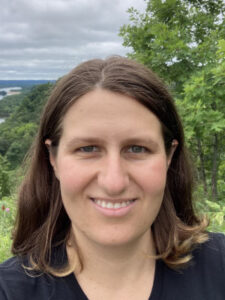While Wisconsin may be known for its “frozen tundra,” an increase in hot, humid summer days is bringing attention to Wisconsin’s urban heat islands and their impact on human health. A heat island is an urban area that experiences higher temperatures than the surrounding rural areas because of buildings, roads, and general infrastructure absorbing heat and emitting that heat back into the environment. Understanding this phenomenon and how to mitigate its health impacts on the urban population is the focus of the new collective, Wisconsin Heat Health Network, which began thanks to the efforts of University of Wisconsin-Madison UniverCity Year leadership.

“It was a year and half ago that I got a call from [UniverCity Alliance Managing Director] Gavin Luter asking me to give a Weston Roundtable presentation on campus,” shared Larry Kalkstein, the president of Applied Climatologists, Inc., and co-founder of the Los Angeles Urban Cooling Collaborative (LAUCC). “We started discussing my work and he thought it might be of interest to the more general population of Southern Wisconsin. So, Gavin convened a group together and we started talking. It exploded basically and right now our group [known as the Wisconsin Heat Health Network] is large.”
The Wisconsin Heat Health Network, which works to build awareness about heat impacts and climate change, now includes not only UniverCity Alliance staff and Kalkstein, but also leaders from the City of Madison and Dane County, the City of Milwaukee and Milwaukee County, the Wisconsin Department of Health Services, Public Health Madison & Dane County, the UW-Madison Global Health Institute, and the Wisconsin Climate Change Initiative (WICCI).

As heat is the number one weather-related cause of death, local leaders and scientists are eager to study its impact and provide scientific-based recommendations for mitigating these risks. As the collaborative works together to develop a plan for dealing with the health impacts, they are utilizing research conducted by principal investigator Kalkstein and Nelson Institute for Environmental Studies graduate student, Elizabeth Berg who works in Department of Agronomy and Nelson Institute Center for Sustainability and the Global Environment (SAGE) affiliate, Chris Kucharik’s lab.
“A lot of what we’ve found is consistent with what people in Madison would tell you. We all know we’ve had extremely rainy summers recently, including bad flooding. We’ve not been having the dry days, it’s the hot humid days that are increasing,” Berg said. “While we’ve been finding that temperatures overall haven’t been increasing, we have found that there is an increase in minimum temperatures that occur overnight.”
Berg explained that this increase in overnight lows is a concern for human health because to recover physically, you need relief from cooler temperatures overnight. Therefore, the increased temperatures during the night make conditions more dangerous for vulnerable populations which include those in urban areas without air conditioning.
“The sharp increase of seven to eight degrees in overnight temperatures is more sizable in urban areas,” Berg continued. “With the urban heat island effect, the warming largely comes from stored and trapped heat in pavement, and you have heat emanating from the ground. It seems like a sign we aren’t just seeing climate change but impacts of urbanization.”
Kalkstein added, “We don’t want to mislead people into thinking that the world is warming at this rate. The fact that the rural areas did not behave like the urban areas is important because if they reacted the same, we could say this is generalized climate change, but since it is the urban areas that reacted more extremely, an increasing urban heat island effect is probably playing a role as well.”
To better understand what temperature increases are related to climate change and what are related to urbanization as well as which weather patterns are most dangerous to human health, Berg and Kalkstein are looking at data from the past 30 years. Berg is leading the analysis of these data. Part of her work includes looking at weather patterns over time and how underlying air masses have impacted the weather and thereby human health. By breaking down the weather patterns into air masses, Berg says scientists can better understand what air masses are creating the biggest impact.
So far, Berg has discovered that it’s the days that are extra hot and extra humid that are the most dangerous, and she has discovered that the number of days that fit that pattern are increasing.
“We’ve been looking at serious outcomes, including mortality data,” Berg shared. “We are trying to understand if we can predict a mortality increase with certain conditions. The goal in understanding that is, if we identified a model, we could work with the local weather forecasting offices for heat warnings.”
Berg noted that the best way to tackle heat risks is to have health-based warnings and advisories in place, along with more sophisticated interventions so that cities and counties can help vulnerable people prepare. The idea is to create a more impact-based heat warning system that is tied to what past data and what that tells scientists about the danger to populations in the area.
“We are still working on this, but we have so far been able to see robust relationships between increased risk of mortality and heat,” Berg confirmed. “For daily mortality going back to 1975, we’ve been able to see across the metropolitan areas a stronger relationship between heat and death in Milwaukee than Madison. Part of this is a population size thing, Milwaukee is bigger than Madison, but it may be due to demographic differences between these two cities as well. In Milwaukee, we see a 10 percent increase in overall deaths on days that are hot and dry, and 4-5 percent on hot and humid days, but we also observed severe racial disparities, with Milwaukee’s Black population facing significantly higher risk on the hottest days than the rest of the population.”
This research from Berg and Kalkstein has led the Wisconsin Heat Health Network to move forward with a variety of initiatives. From an educational standpoint, the collective is sharing this information with Madison and Milwaukee leaders to bring awareness to the issue and encourage changes that will help to mitigate the risks. These changes include improved assistance for the vulnerable as well as infrastructure solutions such as planting more trees or adding reflective roofing to buildings to help deflect heat.
Additionally, the collective is working within the Network to implement a new warning system that would take into account the mortality data in addition to the heat index. The Wisconsin Department of Health Services has submitted a proposal to the Centers for Disease Control so such a system can be developed for Southern Wisconsin.
“Right now, if you hear there is a heat warning, it essentially means that the temperatures have met a meteorological threshold that was arbitrarily set,” Kalkstein said. “We prefer an approach that deals with an outcome. So, our warning system is based on the algorithms and formulas we developed out of the work that tells us the condition and what mortality we can expect. We’re hoping to connect with the National Weather Service once our work is complete about using the heat health warning system as a guidance tool for calling a heat warning.”
Additionally, in his role as chief heat science advisor for the Arsht-Rockefeller Foundation Resilience Center, Kalkstein is working on a heat wave categorization system. As a part of this project, they’ve selected four pilot areas to study, and Wisconsin has been selected as one of the pilot locations along with Kansas City, Los Angeles, and Miami-Dade County in Florida.
“We are going to take a retrospective look at how heat waves would have ranked in the past, sort of similar to how hurricanes are categorized,” Kalkstein said. “So, there are different interventions for each level of the categories, and we think it’s important to do this for heat waves. The National Services in Greece are enthusiastic about the system and are considering using it for major urban areas around the country.”
From Greece to Madison, what started as a simple call between Luter and Kalkstein has grown into a collective with international appeal.
“Again, from just a phone call with Gavin to where we are now is just an enormous thing,” Kalkstein said.
And, while there is more work to do the collaborative is excited for the next steps and to see how the partnerships can help to mitigate the risks of heat in urban areas.
“This effort goes to show that there is power to getting a mix of practitioners and academics in the room to talk about what they see as important issues,” Luter said. “This is a perfect example of what we hope comes from the UniverCity Alliance beyond the typical UniverCity Year program that most people know about. This speaker series turned into a multi-year engagement that is ongoing. I’m so thankful that this group has worked so hard on this under-appreciated aspect related to climate change: the urban heat island effect. Ultimately, we want to prevent deaths associated with heat, and I think this is the right team to usher in the necessary changes.”